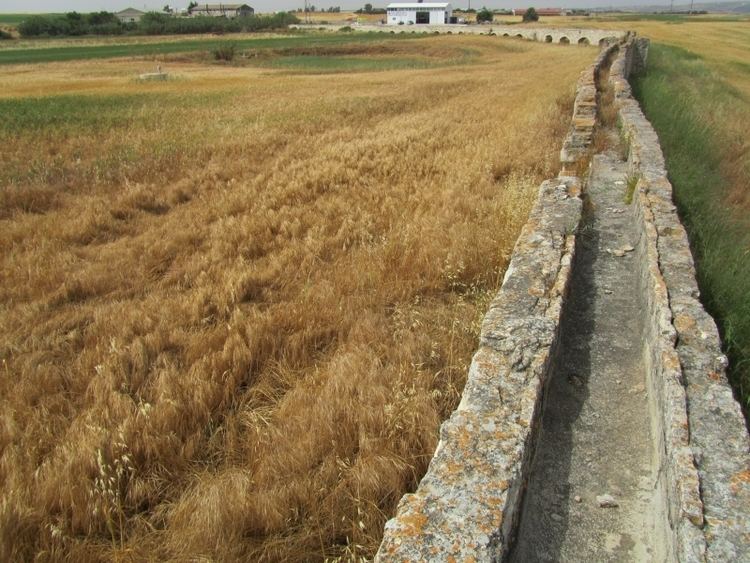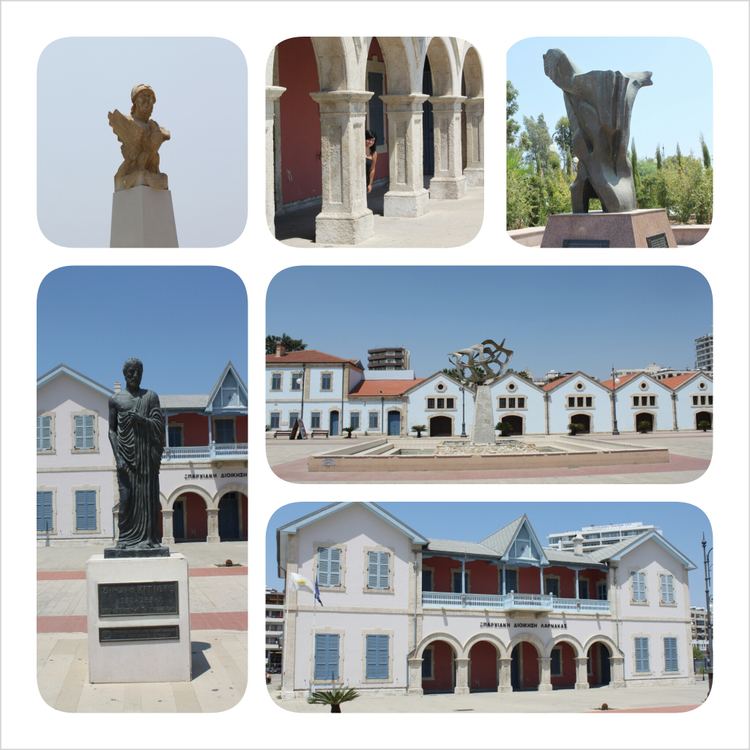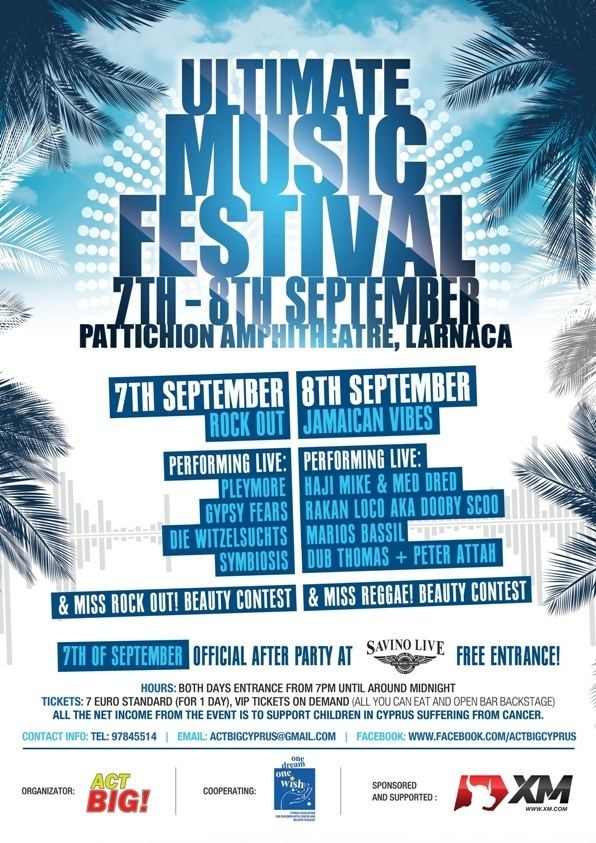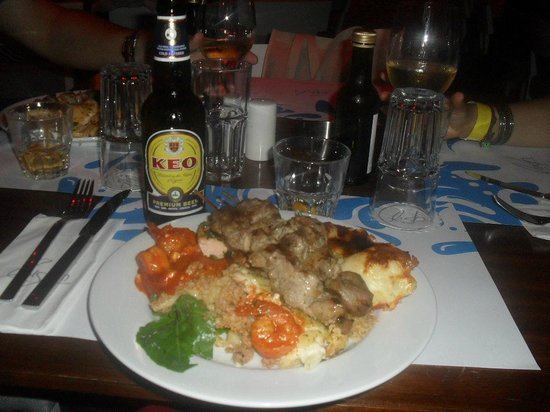Country Cyprus District Larnaca District | University Cyprus College of Art Mayor Andreas Louroutziatis | |
 | ||
Points of interest Hala Sultan Tekke, Larnaca Salt Lake, Church of Saint Lazarus - Larnaca, MS Zenobia, Stavrovouni Monastery | ||
Map of Larnaca
Larnaca (Greek: Λάρνακα [ˈlarnaka]; Turkish: Larnaka or İskele) is a city on the southern coast of Cyprus and the capital of the eponymous district. It is the third-largest city in the country, after Nicosia and Limassol, with an urban population of 84,591 (2011).
Contents
- Map of Larnaca
- Finals skeet women 2015 issf shotgun world cup in larnaca cyp
- Viking divers larnaca cyprus cypriot food is the best food in the world
- Etymology
- History
- Geography
- Climate
- Landmarks
- Monuments
- Economy
- Education
- Arts
- Music
- Sports
- Festivals
- Museums
- Cuisine
- Neighborhoods
- Nightlife
- Transport
- Public transport
- Twin towns sister cities
- Notable residents
- References
Larnaca is known for its palm-tree seafront, the Church of Saint Lazarus, the Hala Sultan Tekke, the Kamares Aqueduct and its medieval fort. It is built on the ruins of ancient Citium, which was the birthplace of Stoic philosopher Zeno.

Larnaca is home to the country's primary airport, Larnaca International Airport. It also has a (both passenger and cargo) seaport and a marina.

Finals skeet women 2015 issf shotgun world cup in larnaca cyp
Viking divers larnaca cyprus cypriot food is the best food in the world
Etymology

Larnaca might have taken its name from the many larnakes (sarcophagi) that are found in the area. Sophocles Hadjisavvas, a state archeologist, states that "[the city's U.S.] consul of the last quarter of the 19th century, claimed to have explored more than 3,000 tombs in the area of Larnaca, so-called after the immense number of sarcophagi found in the modern town".
History
The former city-kingdom of Kition was originally established in the 13th century BC. New cultural elements appearing between 1200 BC and 1000 BC (personal objects, pottery, new architectural forms and ideas) are interpreted as indications of significant political changes and the arrival of the Achaeans, the first Greek colonists of Kition. Around the same time, Phoenicians settled the area.
At the archaeological sites of Kiteon, remains that date from the 13th century BC have been found. Around 1000 BC, Kition was rebuilt by Phoenicians and it subsequently became a center of Phoenician culture. The remains of the sites include cyclopean walls and a complex of five temples and a naval port.
It was conquered in the first millennium BC by a series of great powers of the region. First by the Assyrian Empire, then by Egypt. Like most Cypriot cities, Kition belonged to the Persian or Achaemenid Empire. In 450 BC, the Athenian general Cimon died at sea, while militarily supporting the revolt against Persia's rule over Cyprus. On his deathbed, he urged his officers to conceal his death from both their allies and the Persians.
Strong earthquakes hit the city in 76 AD and the year after.
Earthquakes of 322 AD and 342 "caused the destruction not only of Kition but also of Salamis and Pafos". Kition's harbor silted up, and the population moved to the seafront farther south, sometime after this. (Contributing factors to the silting are thought to have been earthquakes, deforestation and overgrazing.)
The commercial port was located at Skala, during the Ottoman Period. Skala is the name of the seashore immediately south of the Larnaca castle—and its neighborhood. The city is sometimes colloquially referred to as "Skala" (Greek: Σκάλα) meaning "ladder" or "landing stage", referring to the historical port.
The Kamares aqueduct was built in 1747—bringing water to the city from a source around six miles (9.7 km) from the city.
Geography
The Salt Lake fills with water during the winter season and is visited by flocks of flamingoes who stay there from November until the end of March. It usually dries up in the summer. In the past, it yielded good quality salt scraped from the dried surface. The salt from the lake is now considered unsuitable for consumption.
Climate
The climate in this area is described by the Köppen Climate Classification System as a hot semi-arid climate due to its low annual rainfall and strong summer drought. It is sometimes described as a mediterranean climate, but its winter rainfall is below the required amount to avoid the semi-arid classification.
Landmarks
The city's landmarks include: the Church of Saint Lazarus; the Catacomb of Phaneromeni Church; Hala Sultan Tekke; the Kamares Aqueduct; and the Fort of Larnaca.
So-called "Foinikoudes" is the promenade along Athenon Avenue on the seafront. A row of palm trees (Cypriot Greek: φοινικούδες foinikoudes) lines either side of it.
Monuments
Economy
Larnaca's economy has been growing since 1975, after the loss of the Port of Famagusta, which handled 80% of general cargo, and the closure of Nicosia International Airport, meant that Larnaca's airport and seaport had increasingly important roles in the economy of the island. A €650m upgrade of Larnaca Airport has been completed.
The service sector, including tourism, employs three-quarters of Larnaca's labor force. Many travel and tour operators and other travel-related companies have their head offices in Larnaca.
Education
There are over a hundred educational institutions in the city, including the American Academy, Larnaca Nareg Armenian school and the Alexander College.
Arts
Larnaca has a theatre and an art gallery, which are operated by the municipality. The Cornaro Institute was a cultural centre founded by the celebrated Cypriot artist Stass Paraskos in the Old Town in 2007, which staged contemporary art exhibitions and other cultural events, prior to its closure by Larnaca Municipality in 2017.
Music
Local institutions include the Municipal Wind Orchestra.
Sports
Local teams include (football:) AEK Larnaca FC and ALKI Larnaca FC. Due to the Turkish occupation of Famagusta, the two teams of Famagusta, Anorthosis and Nea Salamina, are located here.
Local sports arenas include GSZ Stadium, "Antonis Papadopoulos", and "Ammochostos".
International competitions held in the city, include the Shooting Shotgun European Championships in 2012, the FIVB Beach Volleyball SWATCH Youth World Championship in 2012, the European Under-19 Football Championship final in 1998 and the European Under-17 Football Championship final in 1992.
Larnaca attracts windsurfers from around the world especially in autumn. Mackenzie Beach hosts windsurfing centre together with an extreme sports centre.
Festivals
Much of the activity is centered on the city promenade during the major festivals. The most important of these is Kataklysmos or the Festival of the Flood, celebrated in early summer with a series of cultural events. The festival used to last for about a week, but, in recent years, with the increased commercialism of peripheral stalls, rides and temporary lokmades restaurants, the festival has been extended to about three weeks, during which the seafront is closed to traffic in the evenings. Lokmades (or loukoumades) is a sweet delicacy.
Museums
Museums found in Larnaca include the Larnaca District Archaeological Museum, Pierides Museum and Kyriazis Medical Museum.
Cuisine
The beaches of Larnaca are lined with nearly identical seafood restaurants catering to tourists. Although there are many continental and international restaurants in Larnaca, visitors do not miss out on indulging in the local food. Many of the staple dishes involve beans, such as fasolaki (French beans cooked in red wine with lamb), and louvi me lahana (black-eyed beans with chard). Some of the standard appetizers are potato salad, kohlrabi salad, and hot grilled black olives. The next course may include Cyprus village sausage and sheftalia, dolmades and keftedes, kolokassi in tomato sauce, and several aubergine-based dishes. Baked or grilled lamb (souvla) usually appears somewhere in the course of dining, as does some kind of fish.
Neighborhoods
Larnaca's neighborhoods include Skala, Prodromos, Faneromeni, Drosia, Kamares, Vergina and Agioi Anargyroi.
Nightlife
Club DEEP first opened on October 1, 2010, is a Large club situated in the Heart of Larnaca's Hot Party Spot, providing you with the edgy sounds of RnB, Hip Hop, Bashment & House. It hosts some of the best parties each week and even hosted some of the best DJs in Cyprus.
Transport
The city's transport hubs are Larnaca International Airport and Larnaca Port—the Republic's busiest airport and second busiest port, respectively.
Public transport
Public transport in Larnaca is served only by buses. Bus routes and timetables can be found here.
Twin towns – sister cities
Larnaca Municipality is twinned with the following:
